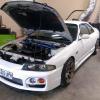R33 Rb30 Conversion
Announcements
-
Similar Content
-
Latest Posts
-
I don’t really have any ideas how to set the timing on the CAS 😂, sounds like the top, sounds like it maybe misfiring as well as ticking, got the box sorted 😌, must of been a air bubble on the clutch side
-
Use a 2' length of hose (that's 2 foot, not 2 inches) as a stethoscope to localise the source of the ticking. From cam covers? From exhaust or turbo manifold gasket? From injectors? From lower down in the engine? Etc. Use a timing light to set the timing. Put Redline Lightweight Shockproof in the box. It's not the very best thing for the box, but it will take a box that refuses to engage a gear with other oil, and make it engage a gear. I had to put it in when I installed the R33 box I have in my car. It would not select ANY gear when running. Smurf jizz made it work. That was >10 years ago and I still use it. I'm stuck with it now. Failing that - rebuild the box.
-
Well done Duncan. The fuel tank bulkhead lid is also in great condition (some of mine were stuffed). These are now out of production and good ones like that are becoming hard to come by.
-
Exterior LEDs R34 2Dr R34 4Dr Position Lamp T10 T10 Winker front T20S T20S side T10 T10 rear T20S S25S150 Anti-hyfla relay TYPE3 TYPE3 tail T10 T20W Stop Lamps T20W T20W High Mount T16 T16 back T16 T20S number T10 T10 trunk T10 T10 Interior LED Item No. Map Lamp BA9S single-sided Room Lamps T10×31 Trunk Lamp T10 meter Early T6.5 pedestal final T6.5 pedestal NISMO T6.5 pedestal Liquid crystal section T6.5 pedestal Winker T6.5 pedestal High Beam T6.5 pedestal 3 SERIES METER Early T6.5 pedestal final T6.5 pedestal NISMO T6.5 pedestal air conditioner Early Liquid Crystal T3 Late LCD T4.2 Short button T4.2 Middle Hazard SW T3 Pedestal Short Keyring T5 Cigar Socket T5
-








Recommended Posts
Create an account or sign in to comment
You need to be a member in order to leave a comment
Create an account
Sign up for a new account in our community. It's easy!
Register a new accountSign in
Already have an account? Sign in here.
Sign In Now